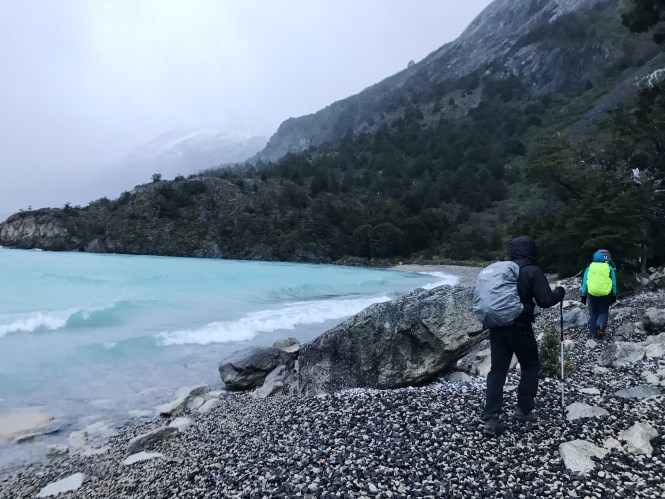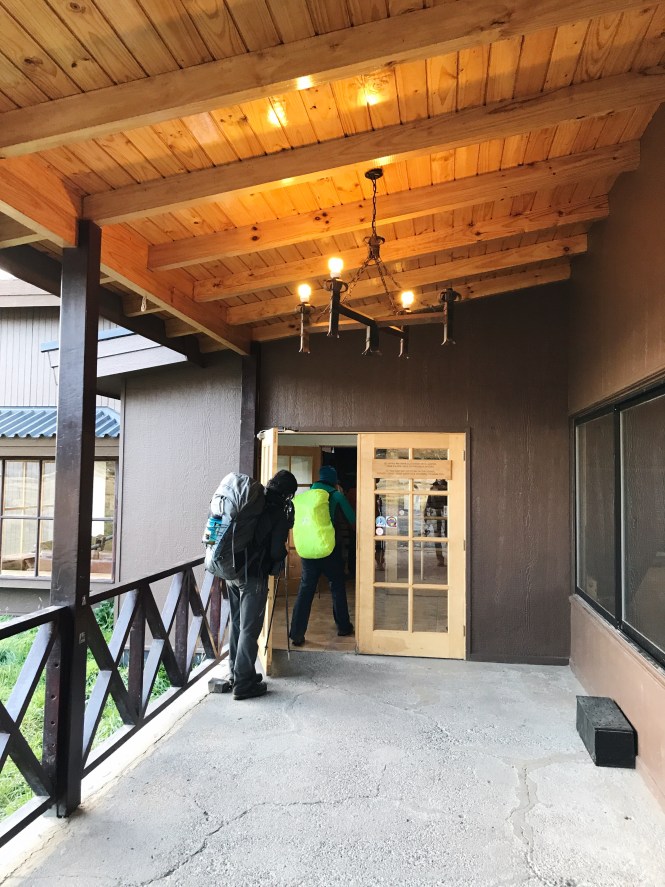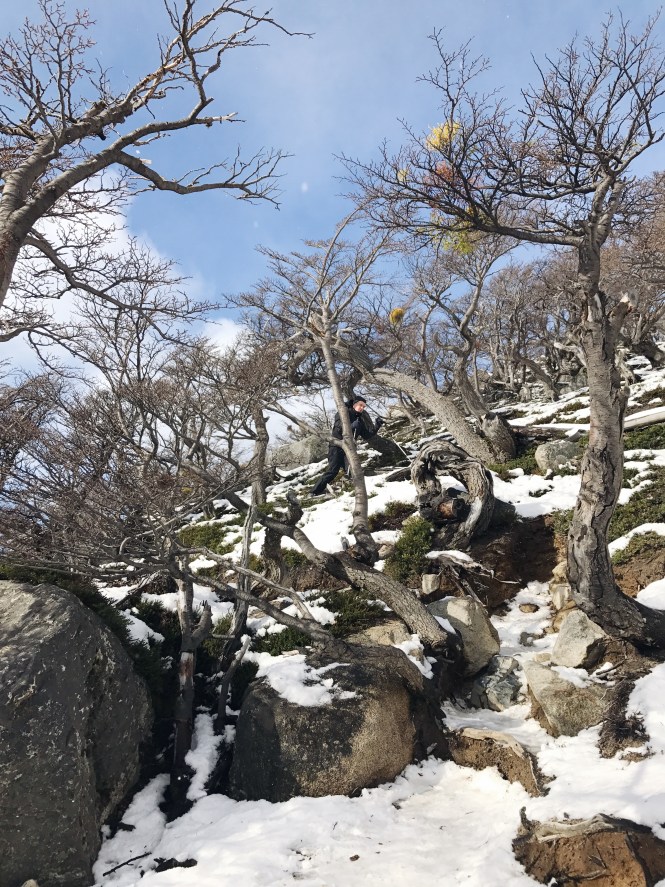
Patagonia has been a long time dream…just not mine.
When Spencer told me he wanted to visit Chile I didn’t think much of it. I honestly found it to be a chore of a trip to make him happy. I was so so wrong.
The first leg our trip was to Santiago and then Patagonia. I had heard of the W Trek before, the 5 day 4 night hike through the Chilean portion of Patagonia. However, I always thought this would be something we would conquer later in life, never something we would do so soon! So, with two weeks to prep before our trip I started to do some intense research of what was needed for this hike. The longest hike either one of us has ever done.
Our hiking trip was booked through Chile Nativo, who coordinates all your shelters, food and transportation to and from Torres Del Paine National Park – I’ll elaborate on their services in the next post and tell you where you need to go and how to get there in order to visit the park. So, given most logistics were taken care of I knew all we needed to bring was our gear. But what gear? We didn’t own any.
I knew that since we would be hiking the Winter W Trek we would need a lot of layers to keep us warm. We were in Patagonia May 23-27 which is the start of winter in Chile. I was able to look up the median temperature on The Weather Channel. They have great resources where you can look up last years records to get a better idea of what to expect. We had also heard the weather at that time could be fickle. Would we experience rain? Snow? Wind? All of the above? Ahhh!
I figured we should go straight to the experts so Spencer and I went to REI. With the help of their staff at the SoHo location and a lot of research we figured out what we needed:
FOR YOUR BODY
Base Layer – this is the first layer you will put on under everything. Hence the “base” name. I initially thought of getting the R.E.I. brand but we were already spending so much money on other layers that I wanted something more affordable. Uniqlo offers three great different options: HEATTECH, HEATTECH Extra Warm, and HEATTECH Ultra Warm. I found Extra Warm and Ultra Warm too heavy so I picked up the following for 5 days:
Tops:
Bottoms:
- HEATTECH Leggings
- HEATTECH Extra Warm Leggings (wore these the first day and they were way too warm under my trekking pants!).
**if you’re staying in a refugio (shelter) you will be able to give your base layers a quick rinse and dry over night***
Fleece – this was fairly simple as there are plenty of options out there. I love the price point and make of Columbia‘s product so I bought a Columbia Women’s Glacial Fleece Iii 1/2 Zip
Puffer – or as our guide, Mauricio, called it – “Puffy”. For this part of my layer I wanted to find something also a bit fashionable that I could wear under coats during winters in NYC. The Uniqlo Ultra Light Down Jacket is perfect because it packs down to a small bag, weighs nothing, is extra warm and the silhouette is quite cool.
Shell – this is the last thing you layer on top of everything else. I needed something rainproof but again, I wanted something somewhat fashionable and functional. I tried a few jackets but ultimately went with REI Co-op Rhyolite Rain Jacket in Black. It’s cool looking and will definitely keep the water out!
Pants – I may have gone back and forth 20 times about really needing these – REI Co-op Activator Soft-Shell Pants – spoiler alert, you do NEED them. No offense to whoever designed these or whoever enjoys wearing them but it was the hardest thing I’ve ever had to convince myself to spend money on. I mean, look at them. But did they keep me dry? You bet! And they also kept me looking incredibly not fly.
Beanie – I lose every single beanie I buy each season – no fail. I either drop it in the subway or I leave it a concert venue or something happens. So, I had to buy a new one for this trip. Again, trying to find something functional and fashionable was the goal. I found this awesome HERSCHEL SUPPLY CO. 2 Pack Quartz Beanie on Revolve – currently sold out but you can find it here. The best part is Spencer and I were able use these interchangeably so we killed two birds with one stone.
Warm Gloves – I can’t give you advise on which ones your should get because I failed miserably in this area…more below.
FOR YOUR FEET
Shoes – as we would be hiking in cold weather and my feet are easily cold I looked for something designed for hiking but also for winter. I tried the Merrell Moab FST Ice+ Thermo Winter Hiking Boots and they were amazing! I didn’t get a single blister. They’re lined with faux shearling so my feet felt like they were on a bed of fluff the whole time. Mmmm..
Socks – just as important as your shoes, if not more, are your socks! You have to find breathable socks that will keep your feet dry and blister free. These MIRMARU Multi Performance Crew Socks were perfect! They were nice and padded so my feet felt like they were in a cloud.
GEAR – all rented
Hiking Poles – we rented these from Chile Nativo at $5 a day. I can’t imagine having done this hike without them. In the past when I’ve seen people use these I’ve though “Wow, they look silly…” but as silly as they look, you will be happy you have them!
Snow Spikes – I kind of hated using these to be completely honest. They were absurdly uncomfortable and hard to get used to but hiking up and down a snowy mountain would not have been possible without them.
Head Lamps – we never used these because we started our hikes very early on and finished them before sunset (pro hikers!) but just in case you get stuck walking in the dark have this handy!
EXTRAS
Travel Towels – you will need a quick drying, lightweight towel. Trust me, you don’t want to add any unnecessary weight to your pack and you don’t want to carry around a wet towel from refugio to refugio. We bought The Friendly Swede Microfiber 2 Pack. Did they feel like a regular towel? No. Did they do the job? Yes.
Flip Flops – you will need these for the showers at the refugios. Fantastico Sur does a great job of keeping the bathrooms clean but why risk it? You don’t want food fungus while in another country. Even in your own country actually…
Sleeping Clothes – needless to say, bring some warm pants and a comfy tee shirt you can wear around the refugio after your daily hike and to sleep in. After hiking for 8-9 hours all you will want is a pair of sweatpants and comfy tee. I went with a pair of yoga pants and a long sleeve I picked up during our trip to Martha’s Vineyard last summer.
Moleskin – be sure to carry some of this just in case you start to feel a blister coming in. It helps with the friction your shoe/sock will cause in certain areas. I bought Dr. Scholl’s Moleskin Plus Padding but you really can pick up any brand. You will need a pair of scissors to cut the moleskin.
Basic First Aid Kit – this was super helpful to have. Luckily we didn’t really need it but if you find a small one with band aids, tweezers, scissors, eye drops, heat/cold packs, etc. bring it along! You never know.
Water Canteen – I have two of these and perhaps I have a slight bias because I went to college where this wonderful product was born but I carried with me my Classic 27 oz Klean Kanteen. You really don’t need anything bigger than that because you will have plenty of opportunities to refill with deliciously cold glacier water along the way.
Batteries/Phone Charger – in cold temperatures your batteries will quickly lose their juice. Pack a few extras just in case for your head lamp. Of course bring your phone charger because how else are you going to document everything?!
Sunglasses – pick up a cheap pair! You don’t want to make the same mistake I made and bring along your expensive beautiful Karen Walker sunnies that you’re too scared to use in fear of ruining.
Sunscreen – do not forget to bring sunscreen! Even if it’s not super sunny you need to protect your skin!
Basic Toiletries – just because you’re in the wilderness doesn’t mean you can’t get clean. All refugios have showers! Pack shampoo, body lotion, toothpaste, toothbrush, deodorant, etc. Of course bring everything travel size. Again, the least amount of weight you can carry the happier you’ll be.
FOR YOUR GEAR
The final question was: “how am I going to carry all of this for FIVE full days without wanting to kill myself?”
The answer: REI Co-op Trail 40 Pack. I wasn’t in love with this backpack’s colorway to be honest. Sadly R.E.I. only offers the Women’s version in Graystone (purple), and Oregano (a very green Khaki). The Men’s version comes in Black (girls like Black too!) but it was too wide in the shoulder for me. I learned to love my Oregano color way after my friend Kenzie told me it reminded her of Troop Beverly Hills.
During the trek I became slightly obsessed with my backpack and ALL the awesome compartments it has. Since we were only doing 5 days we didn’t need more than 40 Lt. each. I was able to fill it but had enough room to still pack the daily lunch the refugio gave us every morning before our hikes. There are multiple zippers and compartments so I was always able to reach anything I needed. It was super comfortable and I never felt the weight of the backpack put any sort of strain on my back. It was all perfectly balanced on my waist.
THINGS I WISH I HAD…
Waterproof Gloves – I had a pair of gloves Spencer let me borrow but they were super bulky and definitely not waterproof. They kept my hands warm for the most part but I think I could’ve done better to be more comfortable
Cheap Sunglasses – as I said above, I had a nice pair I thought I would be able to use but when you need them is when there are rocks flying at you because of the strong wind. You don’t want to put a nice pair of sunnies through that.
Binoculars – I swear I would have seen a puma if only I had a pair…
Slippers – the refugios are warm but not warm enough to walk around in flip flops. I really wish I had a pair of warm slippers to give my feet a little extra comfort at the end of the day. Instead I had to rock the sock + flip flop look. Not my best moment.
THINGS I HAD AND NEVER USED…
Lock – you may need one in the summer due to the large number of people staying at the refugios but given there we were the only people at the refugios it was very unnecessary and heavy. If you do bring one a basic locker one will do the job.
Headphones – maybe I would’ve needed these if the refugios were packed with loud people or if I hated the group I was hiking with but I never used my headphones! I wanted nothing more than to hear the wind blow, the rain hit the ground, the water crashing on the rocks and chat with my hiking group.
Hairdryer – most refugios don’t have power outlets because they want to discourage people from using too much electricity – absolutely fair and great for the environment! I also never actually needed it because I was showering at night after our treks. By morning my hair was dry.
Makeup – I was a little silly to think I would need this…I did use my daily powdered foundation and blush as an extra source of sunscreen but I don’t know why I brought lipstick along!
Next post I’ll tell you how to get to Patagonia, what buses you need to take, how to book them and where to stay!






















































































































































